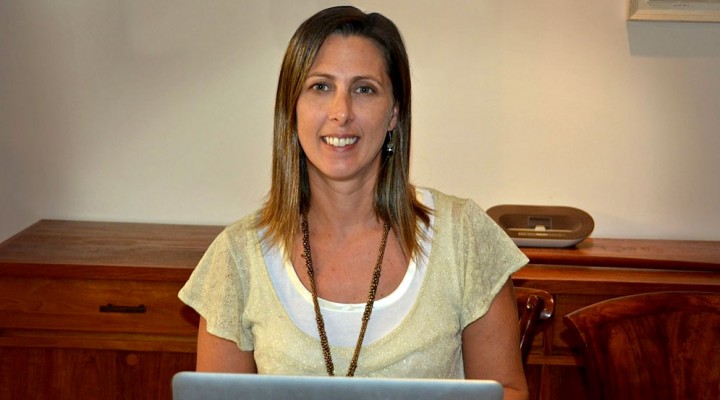MARCH 22: WORLD WATER DAY
The hake and the colour of the sea
CONICET researchers seek to relate satellite information on chlorophyll concentrations in the ocean with the reproductive success of this fish.
Argentine hake (Merluccius hubbsi) is one of the leading fishing resources of the country in terms of commerce. According to the figures provided by the Argentine Ministry of Agroindustry, in 2014 there were 259.202 tons of hake captured, what represents more than 50 per cent of the total amount of fish captured in the region.
Nonetheless, information provided by the Instituto Nacional de Investigación y Desarrollo Pesquero (INIDEP) [National Institute of Fishing Research and Development] shows that since mid-nineties there is a great interannual variability in the number of species’ individuals that exceeds the threshold of the one-year-life, where the death rate increases most. This number is usually known as Recruitment and its knowledge has strategic ecological and commercial importance,.
“The factors that control the interannual variability in hake’s recruitment are not completely known, so that made us seek to relate this process, among other variables, with environmental information – obtained through satellite sensors – on chlorophyll concentration in the area of greatest reproductive activity of the fish” comments Marina Marrari, CONICET assistant researcher at the Servicio de Hidrografía Naval (SHN) [Argentine Navy Hydrographic Service] of the Argentine Navy and main author of the article that contains this development and was recently published in Remote Sensing of Environment.
In practical terms, it could be very important to have the possibility of making a relationship between chlorophyll concentration and the reproductive success of the hake in the Argentine sea, as well as to detect trends in the variability of the thickness of the pigment and to make predictions about it. This information could possibly be used in models to increase the predictive capacity of reproductive success of the species in a given year and to take into account when planning fishing.
Hake larvae feed on zooplankton, which are organisms that live in the open sea which in turn feed mainly on phytoplankton, the organisms that have photosynthetic capacity. Thus, one major concentration of chlorophyll would mean a major availability of food for hake larvae and an increase in the possibility of reaching adulthood.
As well as the hypothesis that will link the largest quantity of chlorophyll with an increase in the recruitment of the hake, the scientists are still working on linking those variables. “In this first study we developed the methodology to obtain time series long in respect of as the colour of the ocean and now we are working with INIDEP researchers to relate that information with the data they have on the reproduction and recruitment of the hake”, the researcher states.
The colour of the ocean seen from the space would be an indicative of the amount of chlorophyll present. “According to the basic principle, the more light on the green region reflects the ocean’s surface, the more chlorophyll is present. The problem is that the satellite information made up of relatively short time series did not allow us to detect long time trends. In order to overcome this problem, we developed a methodology to obtain a unique long series from two shorter ones”, Marrari comments.
The information that was available had two different satellite sensors: one was called SeaWIFS, which operated in the region with high-resolution data from 1997 to 2006, and the other –MODIS Aqua- that entered orbit in 2002 and still collecting information. The idea to combine both series conflicts with the problem that during the five years of superimposition (2002-2006) there were differences in the estimates of both sensors and, for instance, MODIS showed a greater concentration of chlorophyll in peak times.
“So we developed a data correction of MODIS using the period of time in which both sensors overlapped. Basically, we adapted them to make them look like the SeaWIFs. Then we organized all the modifications for the whole time series of MODIS thus producing the only series with more than 17 years for the region”, the researcher explains.
The measures were taken in a region of the Argentine Sea known as the area of the Isla Escondida, located in Península de Valdez and the Golfo San Jorge at the height of the province of Chubut, where the largest spawning of hake, that is to say when the adult hakes lay the eggs, and the largest concentration of larvae is present.
“The most interesting part was that when we began to observe whether there were trends in the concentration of chlorophyll, we found that there is, that in a great part of the study area there was a significant increase in chlorophyll concentration. This has not been detected before, with shorter series”, Marrari affirms.
The possibility of having satellite data about the colour of the ocean and generating long series to detect trends beyond the year-on-year variabilities, opens up the chance of studying a series of fundamental topics not only related to hake fishing but also to the primary ocean and climate change productivity, among others.
By Miguel Faigón
About the research:
Marina Marrari. Assistant researcher. SHN e IFAECI.
Alberto R. Piola. Principal researcher. SHN, IFAECI and FCEN-UBA.
Daniel Valla. Doctoral fellow. SHN, IFAECI and FCEN-UBA.
John G. Wilding. NASA. Goddard Space Flight Center.
